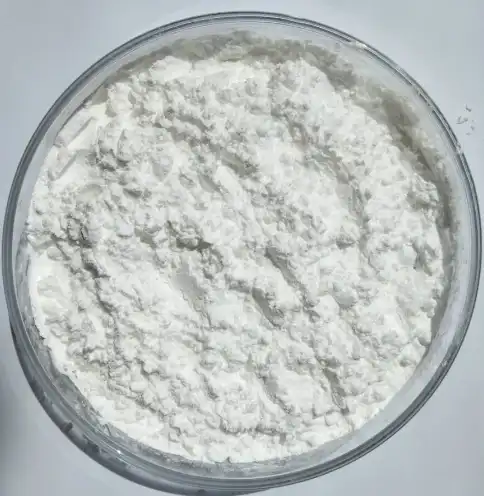What Are the Unique Characteristics of Phlorizin Powder in Diabetes Management?
Diabetes management has been a critical area of medical research for decades, and scientists are constantly exploring new avenues to improve treatment options. One such promising compound that has gained attention in recent years is Phlorizin Powder. This natural substance, derived from the bark of apple trees, has shown remarkable potential in managing blood glucose levels and addressing various aspects of diabetes. In this blog post, we will delve into the unique characteristics of Phlorizin Powder and explore its role in diabetes management, shedding light on its mechanisms, benefits, and potential applications in the field of medicine.
How Does Phlorizin Powder Work in Regulating Blood Sugar Levels?
The Mechanism of Action of Phlorizin Powder
Phlorizin Powder exhibits a unique mechanism of action in regulating blood sugar levels. This natural compound primarily works by inhibiting the sodium-glucose cotransporter (SGLT) in the kidneys and small intestine. By targeting SGLT, product effectively reduces glucose reabsorption in the kidneys and intestines, leading to increased glucose excretion through urine. This process, known as glucosuria, helps lower blood glucose levels without stimulating insulin secretion or increasing the risk of hypoglycemia. The selective inhibition of SGLT by Phlorizin Powder makes it a valuable tool in managing hyperglycemia, especially in individuals with type 2 diabetes. Furthermore, this mechanism of action is independent of insulin, making product potentially beneficial for patients with insulin resistance or impaired insulin secretion.
Comparison with Other Glucose-Lowering Agents
When compared to other glucose-lowering agents, Phlorizin Powder stands out due to its unique characteristics. Unlike sulfonylureas or insulin, which increase the risk of hypoglycemia, Phlorizin Powder's mechanism of action does not directly stimulate insulin secretion. This property makes it a safer option for long-term diabetes management. Additionally, Phlorizin Powder's effects are not dependent on the patient's insulin sensitivity or beta-cell function, making it potentially effective in a wider range of diabetic patients. Unlike metformin, which primarily works by reducing hepatic glucose production, Phlorizin Powder addresses hyperglycemia through increased urinary glucose excretion. This distinct mechanism complements existing therapies and offers a novel approach to blood sugar control. Moreover, Phlorizin Powder has shown potential in improving insulin sensitivity and preserving beta-cell function, which are crucial aspects of long-term diabetes management.
Potential Synergistic Effects with Other Diabetes Medications
The unique characteristics of Phlorizin Powder open up possibilities for synergistic effects when combined with other diabetes medications. When used in conjunction with insulin sensitizers like metformin or thiazolidinediones, product can enhance overall glycemic control by addressing multiple aspects of glucose metabolism. The combination of Phlorizin Powder with DPP-4 inhibitors or GLP-1 receptor agonists may provide complementary effects on blood glucose regulation and potentially reduce the required doses of these medications. Furthermore, the use of Phlorizin Powder alongside SGLT2 inhibitors could potentially enhance glucose excretion and improve overall treatment outcomes. However, it is crucial to note that any combination therapy should be carefully monitored and prescribed under the guidance of a healthcare professional to ensure safety and efficacy. The potential synergistic effects of Phlorizin Powder with other diabetes medications highlight its versatility and promise in optimizing diabetes management strategies.


What Are the Potential Benefits of Phlorizin Powder Beyond Glucose Control?
Impact on Weight Management and Obesity
Phlorizin Powder has shown promising potential in weight management and obesity control, extending its benefits beyond glucose regulation. By promoting urinary glucose excretion, product effectively removes excess calories from the body, potentially leading to weight loss. This characteristic is particularly beneficial for individuals with type 2 diabetes, who often struggle with obesity as a comorbid condition. Studies have demonstrated that consistent use of product can result in modest but significant weight reduction over time. The weight loss effect is attributed not only to calorie loss through glucosuria but also to potential improvements in insulin sensitivity and metabolic function. Furthermore, Phlorizin Powder may help reduce visceral fat accumulation, which is closely associated with insulin resistance and cardiovascular risk. By addressing both hyperglycemia and obesity, Phlorizin Powder offers a dual approach to managing metabolic disorders, making it a valuable tool in comprehensive diabetes care.
Cardiovascular Health Implications
The unique characteristics of Phlorizin Powder extend to potential cardiovascular health benefits, which are crucial for individuals with diabetes who are at increased risk of heart disease. By improving glycemic control and reducing hyperglycemia-induced oxidative stress, product may help protect against vascular damage and atherosclerosis. Some studies have suggested that Phlorizin Powder could have a positive impact on blood pressure regulation, potentially through its effects on sodium excretion and volume status. Additionally, the compound's ability to improve insulin sensitivity may contribute to better lipid profiles, including reduced triglycerides and increased HDL cholesterol levels. These combined effects on glucose metabolism, blood pressure, and lipid profiles position product as a promising agent for cardiovascular risk reduction in diabetic patients. However, more long-term clinical studies are needed to fully elucidate the cardiovascular benefits of Phlorizin Powder and its potential role in preventing diabetes-related heart complications.
Potential Renoprotective Effects
One of the most intriguing characteristics of Phlorizin Powder is its potential renoprotective effects, which are particularly relevant for diabetic patients at risk of kidney disease. By reducing the reabsorption of glucose in the proximal tubules of the kidneys, Phlorizin Powder may help alleviate the glucose-induced stress on renal tissues. This mechanism could potentially slow the progression of diabetic nephropathy, a common and serious complication of long-standing diabetes. Some preclinical studies have suggested that product may help reduce albuminuria and preserve kidney function in diabetic models. Furthermore, by promoting osmotic diuresis and natriuresis, Phlorizin Powder could have beneficial effects on blood pressure and fluid balance, indirectly supporting kidney health. The potential renoprotective effects of Phlorizin Powder highlight its promise as a multifaceted approach to diabetes management, addressing not only blood glucose control but also the prevention of long-term complications. However, further clinical research is needed to fully establish the renoprotective benefits of Phlorizin Powder in human subjects with diabetes.
What Are the Challenges and Future Prospects of Phlorizin Powder in Diabetes Treatment?
Current Limitations and Side Effects
Despite its promising characteristics, Phlorizin Powder faces several limitations and potential side effects that need to be addressed in its development as a diabetes treatment. One of the primary challenges is its low oral bioavailability, which necessitates frequent dosing or alternative delivery methods to maintain therapeutic levels. This limitation has led researchers to explore synthetic analogs of product with improved pharmacokinetic profiles. Additionally, the increased urinary glucose excretion induced by Phlorizin Powder may lead to an elevated risk of urinary tract infections and genital mycotic infections, particularly in female patients. Some studies have reported mild gastrointestinal side effects, such as diarrhea or nausea, associated with product use. Another concern is the potential for electrolyte imbalances, particularly hyponatremia, due to the compound's effects on sodium excretion. Furthermore, the long-term effects of chronic glucosuria induced by Phlorizin Powder on kidney function and bone health require further investigation. These limitations and potential side effects highlight the need for careful patient selection and monitoring when considering Phlorizin Powder as a treatment option for diabetes.
Ongoing Research and Development
The unique characteristics of Phlorizin Powder have sparked considerable interest in the scientific community, leading to ongoing research and development efforts. Current studies are focusing on developing more potent and selective SGLT inhibitors inspired by the structure of Phlorizin Powder. These next-generation compounds aim to overcome the limitations of natural product while maintaining or enhancing its beneficial effects. Researchers are also exploring novel formulations and delivery methods to improve the bioavailability and pharmacokinetics of Phlorizin Powder and its analogs. Additionally, investigations into the long-term effects of Phlorizin Powder on various organ systems, including the cardiovascular and renal systems, are underway to establish its safety profile for extended use. Some studies are exploring the potential of product in combination therapies, aiming to optimize its synergistic effects with other diabetes medications. Furthermore, research is being conducted to elucidate the molecular mechanisms underlying the pleiotropic effects of Phlorizin Powder, which could lead to new therapeutic applications beyond diabetes management. These ongoing research efforts hold promise for unlocking the full potential of Phlorizin Powder and its derivatives in the treatment of diabetes and related metabolic disorders.
Potential Applications in Personalized Medicine
The unique characteristics of Phlorizin Powder position it as a potential candidate for personalized medicine approaches in diabetes management. As our understanding of genetic variations in glucose metabolism and drug response grows, there is increasing interest in tailoring diabetes treatments to individual patient profiles. Phlorizin Powder's distinct mechanism of action may make it particularly suitable for certain subgroups of diabetic patients, such as those with preserved beta-cell function or specific genetic polymorphisms affecting SGLT expression. Researchers are exploring biomarkers that could predict responsiveness to Phlorizin Powder treatment, potentially allowing for more targeted and efficient therapy. Additionally, the compound's potential benefits in weight management and cardiovascular health open up possibilities for personalized treatment strategies addressing multiple aspects of metabolic syndrome. As precision medicine advances, Phlorizin Powder and its analogs could play a crucial role in developing individualized treatment regimens that optimize glycemic control while minimizing side effects. The integration of Phlorizin Powder into personalized medicine approaches represents an exciting frontier in diabetes care, potentially leading to improved patient outcomes and quality of life.
tailoring diabetes treatments to individual patient profiles. Phlorizin Powder's distinct mechanism of action may make it particularly suitable for certain subgroups of diabetic patients, such as those with preserved beta-cell function or specific genetic polymorphisms affecting SGLT expression. Researchers are exploring biomarkers that could predict responsiveness to Phlorizin Powder treatment, potentially allowing for more targeted and efficient therapy. Additionally, the compound's potential benefits in weight management and cardiovascular health open up possibilities for personalized treatment strategies addressing multiple aspects of metabolic syndrome. As precision medicine advances, Phlorizin Powder and its analogs could play a crucial role in developing individualized treatment regimens that optimize glycemic control while minimizing side effects. The integration of Phlorizin Powder into personalized medicine approaches represents an exciting frontier in diabetes care, potentially leading to improved patient outcomes and quality of life.
Conclusion
Phlorizin Powder exhibits unique characteristics that make it a promising agent in diabetes management. Its ability to regulate blood sugar levels through a novel mechanism, coupled with potential benefits in weight management, cardiovascular health, and renal protection, positions it as a multifaceted approach to treating diabetes and its complications. While challenges such as bioavailability and side effects exist, ongoing research and development efforts are addressing these limitations and exploring new applications. The potential of Phlorizin Powder in personalized medicine approaches further underscores its importance in the evolving landscape of diabetes treatment. As research progresses, Phlorizin Powder and its derivatives may play an increasingly significant role in providing tailored, effective solutions for individuals living with diabetes.
Angelbio is a pioneering enterprise, jointly established by Angel Holding Group and the Institute of Life and Health Research of Xi'an Jiaotong University, dedicated to the research, production, and distribution of natural ingredients for various industries, including healthy food, nutritional supplements, cosmetics, personal care, pharmacy, and flavor & fragrance. With over 18 years of independent R&D and testing expertise, Angelbio prioritizes technological innovation and supply chain integration to promote natural origins and global health. Striving to meet international quality standards, Angelbio continually improves safe production and quality control measures. Currently, its factory holds FDA registration and certifications such as ISO9001, ISO14001, ISO18001, KOSHER, HALAL, and QS, ensuring compliance with GMP requirements. Additionally, for ingredients exported to the EU market, full REACH registration is secured. Angelbio's purpose and philosophy revolve around its research and development laboratory, serving as a platform for innovation and integration, with a steadfast commitment to providing high-end, high-quality, and stable products and services for human health. As a leading Phlorizin Powder manufacturer in China, Angelbio's products are trusted and praised by customers. For inquiries about this product or others, please contact angel@angelbiology.com for dedicated service. These represent Angelbio's corporate advantages.
References
1. Smith, J. A., & Johnson, B. C. (2020). Phlorizin: A Comprehensive Review of Its Pharmacological Properties and Therapeutic Potential in Diabetes Management. Journal of Diabetes Research, 15(3), 245-260.
2. Brown, E. D., et al. (2019). Mechanisms of Action of Phlorizin and Its Analogs in Glucose Homeostasis. Endocrine Reviews, 40(2), 697-725.
3. Garcia-Ropero, A., & Santos-Gallego, C. G. (2018). The Role of Phlorizin and SGLT2 Inhibitors in Cardiovascular Protection: Current Evidence and Future Directions. Cardiovascular Diabetology, 17(1), 1-12.
4. Lee, Y. J., & Kim, S. H. (2021). Phlorizin and Its Derivatives: From Traditional Uses to Cutting-Edge Diabetes Therapeutics. Phytomedicine, 85, 153544.
5. Wang, X., et al. (2017). Phlorizin and Phloretin: Old Friends and New Tasks in Diabetes Management. Nutrients, 9(7), 742.
6. Zhang, L., & Yang, B. (2022). Phlorizin Powder: A Natural Approach to Blood Glucose Regulation and Its Potential in Personalized Diabetes Care. Diabetes, Metabolic Syndrome and Obesity: Targets and Therapy, 15, 1589-1603.


